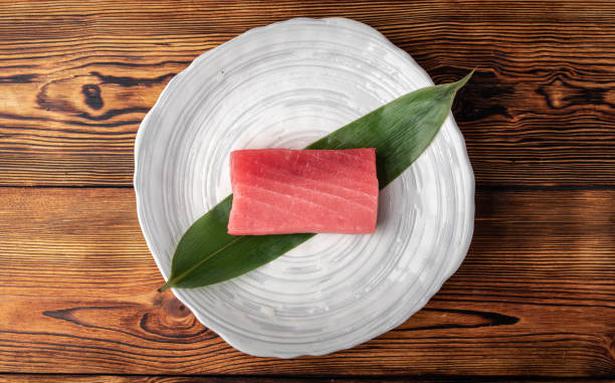Fisherman-turned-Puducherry entrepreneur M Muthu Vel has trained the fishing community to land high-quality tuna, which is now fetching record prices
Fisherman-turned-Puducherry entrepreneur M Muthu Vel has trained the fishing community to land high-quality tuna, which is now fetching record prices
The whopping $145,000 paid for 211 kilograms of bluefin tuna at the first Tokyo tuna auction of 2022 may not have an immediate impact on M Muthu Vel in Puducherry or his bank account. But he’s using the news to inspire fishermen in his area to land good-quality tuna. “Look: It can fetch record prices,” he says.
Since 2018, fisherman and entrepreneur Muthu Vel has been training a group of around 150 fishermen on how to handle the fish prized by Japanese chefs in order to improve the quality of what is brought ashore. “The quality of the tuna that lands in India is poor. This is because our fishermen are not trained in handling the fish, their small boats are poorly equipped and lack the resources to keep the catch fresh,” says Abdus Samad, Chief Scientist, CMFRI in Kochi.
In 2015, Muthu Vel and his wife Anitha opened Aurofish in Muthiyalpet, Puducherry, offering fresh seafood. He launched Saku Block, the premium tuna used in sushi, in November 2021 and was acclaimed by the Government of India’s Department of Fisheries in the Best Innovation/Infusion Technology category. Muthu Vel has since joined online auctions to get the best price (₹1,250 for 500g) for his high quality Saku block.
Yellowfin tuna in Indian waters

Muthu Vel and Anitha run Aurofish, a fish shop in Muthiyalpet in Puducherry
India is one of the largest producers of yellowfin tuna with an annual catch of 32,000 to 35,000 tons. The flesh of the fast-moving predatory fish is used in high-end Japanese cuisine and used in a variety of foods from gourmet dishes to canned and pet foods. The price depends on the quality of the meat, which can range from ₹100 for a whole fish to ₹3,000 for a kilo. Sashmi-grade tuna comes from fish caught with longlines, a technique that uses baited hooks. The fish is caught below the thermocline, a distinct layer of water with varying temperatures.
Premium yellowfin saku is popular with Japanese chefs for its uniformity, which makes it ideal for sashimi and other sliced presentations. “We catch a lot of tuna, but only the good quality meat fetches a top price. This is the only way for fishermen to benefit,” says Muthu Vel, adding that the quality of the tuna depends on how the fish is treated after it is caught and before it is landed.
Muthuvel believes in sustainable fishing and has provided the fishing boat with ice and ice boxes as part of the training. He has also taught local fishermen how to keep their catch as fresh as possible. “Catch live fish, drain it and chill it.”
“Quality is assured when the fish is treated scientifically,” says Muthu Vel, who learned how to make saku blocks, or rectangular fillet slices, from a Japanese buyer. The know-how comes from experience and also requires a special knife.
He recalls catching a huge 85-kilogram tuna 60 nautical miles off the waters of Puducherry and points out that the Bay of Bengal is rich in the species. Tuna follow their food in the oceans, be it a school of anchovies, mackerel, sardines or the like, migrating long distances
Sustainable fishing at Pudimadaka

Local fishermen transport tuna | Credit: Heri Mardinal
Another advocate for sustainable tuna fishing is Tarun Kurushingal from Kochi, who has trained fishermen from the village of Pudimadaka in Andhra Pradesh on how to handle the catch on board. “Tuna can sell for as little as £100 for a whole fish up to around £3,000 a kilo. Getting the fish to a quality where it fetches a premium price is the challenge,” says Tarun, adding that the Japanese have a method of preserving the meat’s freshness.
Tarun’s company Cross Currents supports the community with training and provides them with ice, ice boxes, tools and a buyback offer. The catch is sorted and processed and the quality meat taken to Thailand for further value creation, which Muthuvel does at source.
“I believe the business should be run sustainably, with smaller boats, smaller fish volumes, shorter trips and smaller crews, like Muthu Vel is doing. The super trawlers are cleaning the waters of all fish and that is not good for the country or the fishing community. It affects the livelihood of fishermen and also affects the ecology of the water,” says Tarun, who moved his sustainable community project Cross Currents to Vishakapatnam during the pandemic. This year, he says, they’ve already managed to process “a few hundred tons of tuna.”
Handling tuna on board
Sashimi-grade tuna comes from longline-caught fish weighing at least 50 pounds
The fish is landed on a soft surface like a mattress on the boat to avoid bruising the meat
It is clubbed to keep it from tumbling around and also to avoid the formation of lactic acid.
Incisions are made to bleed the fish and the fish dies.
Then the gills and intestines are removed and the cavity thoroughly cleaned.
The cavity is filled with ice and the fish in the hold is completely covered with ice. The tuna is now ready for further processing once it reaches shore.
Faraz Javeed, director of Abad Fisheries and founder of Wildfish Seafood Store, a gourmet fish cold chain, in Kochi, says the government has made several attempts to train fishermen to preserve the quality of tuna on board. “The quality cannot be restored upon landing,” he explains, adding that the four common tuna species found in Indian waters are bigeye, yellowfin, albacore and skipjack.
Abdus Samad regrets that the great potential of yellowfin tuna is not being realized in India and commends the small efforts of entrepreneurs like Muthu Vel. While the waters of Lakshadweep and the Andaman Islands are rich in tuna, the ports of Kochi and Vizhinjam lead the tuna landings, followed by Visakhapatnam and Mangaluru, he adds.
Meanwhile, Muthu Vel recalls the moment he first tried sushi at the Japanese Consulate in Bengaluru, where he was invited to attend the Japan National Day reception on February 21, 2020. “Feeling lucky,” he wrote of his excitement at eating the famous gourmet meal, posting a picture of it on Instagram. “We fishermen look at tuna very differently now,” he says with a laugh on the phone from Puducherry.



